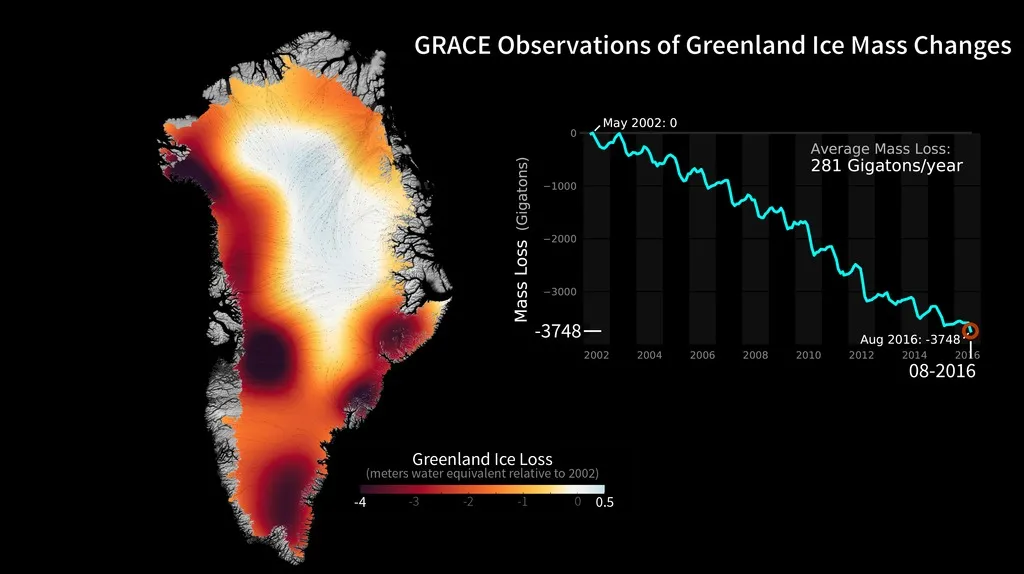Why Scientists Are Watching Greenland
In this free climate change resource, learn why melting ice in Greenland is causing global sea level rise.
Greenland’s Tracy and Heilprin Glaciers Melt
Use the slider to see the changes.
The climate is changing. Retreating glaciers; rising sea levels; hotter and more acidic oceans; and more frequent, stronger storms: all of these changes can be traced to an increase in the earth’s average temperature, which is about 2°F higher today than it was near the turn of the twentieth century.
But the consequences of climate change are more complicated and connected than what a simple list of weather events implies. For example, floods caused by rising sea levels can destroy infrastructure and displace communities, exacerbating issues like poverty, instability, and migration.
Enter Greenland, where a changing ecosystem illustrates the complexity of climate change.
Why are sea levels rising?
For at least five thousand years, sea levels were more or less stable. But since the end of the nineteenth century, average sea level has risen about eight inches, and it is rising faster now: roughly one-third of that increase has happened in the past twenty-five years.
So why are sea levels rising? A major factor is glacier melt, and scientists are particularly concerned about Greenland’s melting. Eighty percent of Greenland is covered by an ice sheet, or large area of land covered in glacial ice. It’s one of only two ice sheets in the world. (The other is in Antarctica.)
Melting is not normally cause for alarm. It is a seasonal process: ice sheets melt in the summer, and then typically regain their mass through water that refreezes in the winter.
How does climate change affect the cycle of ice melting?
Here is how the process of melting and refreezing has looked for thousands of years:
But climate change has interrupted this process. Exposed to warmer weather for a longer portion of the year, Greenland is now experiencing a longer melt season than normal, which means it is shrinking. Think of it as a receding hairline: hair still grows, but not quickly enough to outpace hair loss.
Most scientists agree that feedback loops—or self-reinforcing cycles—are occurring in Greenland. This means that as hotter temperatures spur more melting and longer melt seasons, two related consequences occur: First, older, darker ice is exposed. Like a black shirt absorbing more heat than a light-colored one, this darker ice absorbs more of the sun’s energy and accelerates the natural melting cycle. Second, meltwater also travels down moulins, or ice tunnels, that extend to the bottom of the ice sheet, and lubricates the space between the ice and the bedrock. This causes ice to break off and move more quickly out to sea where it will melt. So, again, the more ice that melts on the surface, the more quickly glacial melt occurs.
Not only is melt season now a couple of months longer, but more of the ice sheet is melting. The island lost around five trillion tons of ice since the early 2000s.
The video below illustrates this phenomenon. In the map on the left, you can see the area where melting was observed expand every year. In the graph on the right, you can see the amount of ice rise each winter and fall each summer. But every year, more is lost than gained.
And as more ice melts, the higher sea levels rise.
What are the effects of sea level rise?
Rising sea levels have their own adverse effects.
Higher sea levels threaten coastal cities, increase flooding, and intensify storms. This put millions of people at risk: 40 percent of the U.S. population lives in coastal areas, and eight of the world's ten largest cities are near a coast.
This map shows coastal areas that would likely be flooded at least once a year with sea levels projected for 2100 scenario where the world limited warming to 2° Celsius (a Paris Agreement target).
Rising Sea Levels
Search for a location to see if it will be at risk of flooding in 2100.
If all of Greenland’s ice melts—which could happen if temperatures rise by more than 2°C—sea levels would eventually rise by twenty-three feet. That is higher than the average two-story house. That is why scientists are tracking Greenland’s ice loss so carefully.
There is no going back for Greenland. The feedback loops created by rising temperatures mean that Greenland will probably continue to rapidly lose ice for years to come, even if greenhouse gas emissions completely stop tomorrow. But scientists believe that by studying Greenland, they can achieve a better understanding of the wide range of consequences climate change will have on other parts of the world—and help people prepare to adapt to the new reality it will bring.





